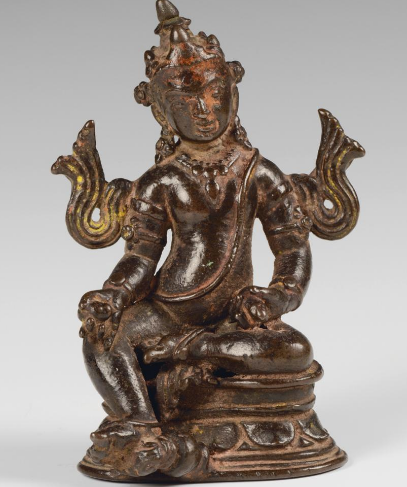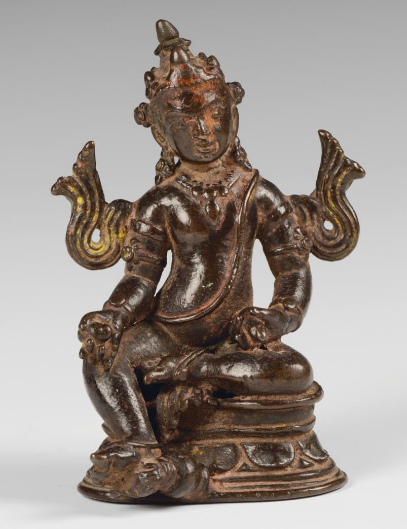Details
- Title : JAMBHALA
- Year : 14th Century
- Classification : Sculpture
- Medium : Bronze
- Dimension : Height 3 1/4 in. (8.2 cm.)
- Accession No : GNM_LOT 87_PUN_30
- Country/ Geo-location : Nepal
- Collection : PUNDOLE’S
- Status : LIVE AUCTION The Art of the Himalayas from the Collection of Roshan Sabavala (M0009) (as per DEC 2021)
- ESTIMATED : ₹40,000 - ₹60,000
- SOLD : ₹75,000
- NOTE : Yellow Jambhala is seated in lalitasana on a lotus pedestal. He holds a mongoose in his left hand and a fruit in his right. He is adorned with heavy bracelets, anklets and a broad bejewelled necklace, his head surmounted by a foliate crown, his right foot resting on a treasure. Konchog Lhundrub (1497 - 1557) outlines the iconography of the Yellow Jambhala in the One Hundred Methods of Accomplishment, stating 'Yellow Jambhala with one face and two hands. The right hand holds a bijapuraka [fruit] and the left a mongoose with jewels showering down. Two feet pressing down on a conch and lotus treasure. [He is] adorned with a blue utpala garland and jeweled ornaments.' (www.himalayanart.org) Yellow Jambhala wears ornaments similar to that of a bodhisattva. The iconography follows that of Yaksha figures in Indian art, and is similar to the appearance of the Four Guardian Kings in Tibetan art. Jambhala is worshipped as a wealth deity and rituals and meditations are done for the purpose of acquiring wealth. One ritual in particular, requires a physical representation, in the form of a small sculpture. The ritual involves pouring 108 offerings of water over the head of Jambhala, whilst reciting a short mantra.

